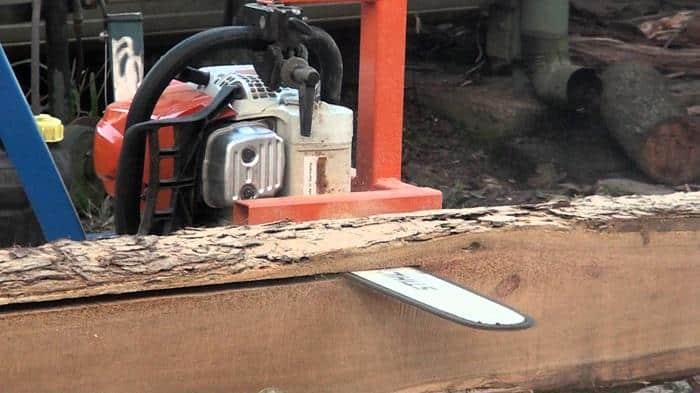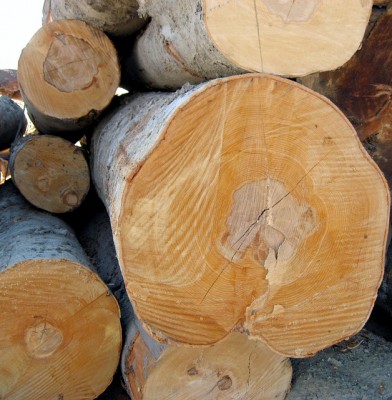Before the invention of the sawmill, cutting logs into flat boards was a tedious, time-consuming and physically intensive process involving the use of wedges, mallets, axes and a tool called an adze, plus draw shaves and hand planers. It could take a day just to make a few boards, and the surfaces were rough and the boards were often twisted and warped.
Circular Sawmills
All of that changed with the invention of large circular saws. Some were driven by water power and later by steam power. The logs were set on a large table and slowly moved toward the saw blade to cut boards. The result was a cleaner cut and the ability to saw more timber in a single day.
Unfortunately, the large circular sawmills were expensive and complex and required a large, dedicated space for both the mill and the equipment surrounding it.
Bandsaw Mills
An innovation that emerged in the 1900s was the band saw. This allowed for a horizontal cut as opposed to the vertical cutting of the circular saws, and was smaller in size. It started in the cattle butchering industry, and someone figured out it could probably cut wood as well.
Unlike a fixed, circular saw blade, the band saw itself moved down the course of a log to make the cut and was then pulled back and lowered to do the next cut.
Some skilled do-it-yourselfers have figured out how to build a band sawmill, but it requires significant technical and mechanical skills, plus a good amount of investment in time, money and space.
The Chainsaw Mill
Finally, there’s the chainsaw. This was largely used for harvesting trees and cutting logs for firewood, but there are some simple and inexpensive attachments that would allow you to create a portable chainsaw mill that you can take into the woods with you to cut rough boards and timber. This is the do-it-yourself sawmill we’re going to explore.
Most people prefer the chainsaw mill because of its low cost and portability and the ability to store it easily. (When looking for supplies for your own mill, search for “chainsaw sawmill.”
Let’s begin by taking a look at this video.
Story continues below video
The prices for a chainsaw mill rig range from $100 to $250. Based on reviews and my own experience, I’d spend more to get the best quality and performance. It is way less than the thousands you might spend for a bandsaw or large circular sawmill.
Here are a few things to keep in mind if you want to use a chainsaw sawmill:
- You need a powerful and well-built chainsaw. You will be putting a tremendous amount of stress on the saw as you make long, rip cuts along the length of logs that can be a foot in diameter or more.
- The blade needs to be at least 16 inches, and larger blade lengths would be better. The more you can get the belly of the blade into the wood, the easier the rip, especially when you get into the dense heartwood of the log.
- You absolutely must buy a “ripping” chain. All chainsaws come with a standard “cutting” chain. These are designed to cut against the grain to turn a downed tree into logs usually used as firewood. A rip-cut is when you are cutting with the grain. A standard “cutting” chain performs poorly for rip cuts because the teeth in the chain are aligned and shaped differently.
This Survival Energy Product Makes Every Window A Powerful Solar Charger [3]
- You might consider having an extra rip chain on hand and a sharpening kit.
- You’ll want to have extra gas and chain oil and oil for the gas mix on hand. You are going to be burning through gas and oil at about four times the usual rate because of the duration of your cuts at full throttle. It’s not like cutting firewood, where you have short duration cuts interspersed with idles. These rip cuts go on and on.
-
Rest the saw now and then. This type of sawing puts a lot of strain on the saw, and you want it to cool down before adding gas. You also might have to check the chain oil with greater frequency than the gas, so keep an eye on the chain oil chamber.
- Take your time and let the saw do the work. Like anything else involving large rotating blades, this is dangerous stuff if you get complacent or impatient.
Chainsaw Mill-Cutting 101
- Only rip-cut well-seasoned logs that are thoroughly dry. If you think cutting green firewood is tough, wait until you try to rip through the log of a green tree.
- Isolate those logs that are as straight as possible. When you start ripping, you’ll be cutting on a straight, level line. Curves in a trunk will reduce the amount of useable timber you harvest.
- Think about your end-use. Is this for framing? Then use a softwood. Is this for rustic furniture? Think about a hardwood. Just remember how hard it is to cut hardwoods.
- Cut your first slab of curved wood/bark to get a flat side, and then support that flat part of the log above the ground. Keep slabbing until you get a long, squared timber. Now you can start cutting your boards. Think ahead once again to what your final use will be and the size or sizes you want.
- Know when to quit. If you or the saw seem to be getting a bit worn out, call it a day.
Practice, Practice, Practice
Start with a smaller-size log about four feet long to get the hang of how to handle this chainsaw mill rig. I’d also start with a log no larger than 12 inches in diameter that is well-aged. This will give you a chance to get a feel for how to best manage the saw and the braces to make the best rips.
In time, you may find it provides you with a good resource for timber across a variety of construction projects, from sheds to barns to your home.
Have you ever made or used a do-it-yourself sawmill? Share your advice in the section below:
Are You Prepared For Blackouts This Winter? Read More Here. [5]


